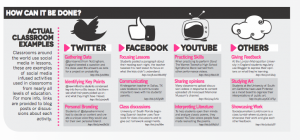 ”I went to the district and said ‘Kids are using it; I’m using it, so it is foolish not to let them access it,’” Dorway said. “When kids screw up with writing notes, we don’t take away paper and pencils.”
”I went to the district and said ‘Kids are using it; I’m using it, so it is foolish not to let them access it,’” Dorway said. “When kids screw up with writing notes, we don’t take away paper and pencils.”
Six months later, his wish was granted. Today, Chanhassen High School blocks only what is required by law and keeps almost all other sites open. While FHSD is bound by similar restrictions, social media sites are open at Chanhassen but not FHN.
“The Internet is a great resource,” Eastern Carver County Schools board member Heather Nelson said. “The world is at your fingertips. It takes you beyond what the teacher knows.”
New Tech High at Coppell in Texas has a similar policy. While the school does block some sites considered inappropriate for minors, other sites such as YouTube, Facebook and Tumblr are left open.
“It’s another way of learning,” New Tech Director Deanna Harrell said. “To cut it off would be to give up collaboration.”
These open policies at New Tech and Chanhassen allow teachers to use social media as a learning tool. Chanhassen English teacher Travis Rother finds a multitude of ways to use social media in the classroom. Through blogging sites, his students work together outside the classroom, and when his classes read a novel, the students tweet from different characters’ perspectives instead of writing book reports.
“We learn together,” Rother said. “Sometimes we make mistakes, but you have to be willing to do that. I’ll always use it as a learning tool for kids.”

With this philosophy, Rother tries to teach students about the Internet by incorporating it into his classroom.
“I think students have to learn about how to use social media professionally and appropriately,” Rother said. “They need to learn what’s okay to post because you are essentially branding your name. It’s nice to do that in the classroom as a learning tool.”
Rother isn’t the only one at Chanhassen taking steps to teach students how to be responsible on the Internet. During homeroom, Chanhassen students participate in a program called Pause Before You Post.
“Obviously we deal regularly with students flaming each other on social media avenues,” Dorway said, “and this is just another attempt for us to say ‘Before you put something out there, you should probably think about it.’”
With this program in place, Dorway said he has never had one student abuse another on a school computer. Dorway also says that Chanhassen faces no problems with bandwidth, an issue that FHSD officials site as one of the reasons access to certain sites is limited. There are also no bandwidth problems at New Tech.
One problem the schools do deal with, though, is students using social media sites while they are supposed to be doing classwork. Rother deals with this problem by speaking bluntly to his students.
“It’s one of those things that if I tell kids not to get on Facebook, they don’t get on Facebook,” Rother said.
Harrell views this problem with the attitude that if students don’t learn how to deal with online distractions during high school, they are left unprepared for college.
“Yes, I get on Facebook too, but then I can’t get my work done,” Harrell said. “We want you to make those mistakes while there are opportunities to work through that as opposed to making that mistake freshman year of college and dropping out.”
Rother agrees that while problems may come up when using social media in schools, the advantages outweigh the disadvantages.
“I just think it’s so much a part of everyday life that there’s no longer a separation from school and social media,” Rother said. “The more we try to push it away from education, the worse education is going to get technology-wise. Why does a kid need to know all the presidents of the United States if they can go on their smartphone and get it in seconds? Why do we make them memorize that but not teach social media?”













![Ninja Christmas [Comic]](https://FHNtoday.com/wp-content/uploads/2024/12/Ninga-Christmas-Comic-1200x898.jpeg)



